~~~~~ Happy Nowruz! ~~~~
What is Nowruz you ask?….. It’s a 3000-year old Persian celebration of spring, rebirth of nature, and hopes for a wonderful new year ahead. It literally means “a new day”. It’s celebrated in many countries in Asia and middle east , such as Iran, Tajikestan, Azerbaijan, and Uzbekistan.
To welcome spring and the new year, families set up “Haft-Seen”, a table of at least seven items, whose name start with the letter “س” in Farsi language (pronounced same as letter “S” in English). Each of these items symbolises a unique wish for the new year. The staples of this beautiful table setting are:
1- Sabzeh: Meaning sprouts (of wheat, lentil or mung beans), symbolising rebirth
2- Sekkeh: Meaning coins, symbolising prosperity
3- Sa’at: Meaning clock, symbolising happy times
4- Somagh: Meaning Sumac, the spice,for the (colour of ) sunrise, symbolising renewal
5- Serkeh: Meaning vinegar, symbolising old-age and patience
6- Sib: Meaning apple, symbolising beauty
7- Sir: Meaning garlic, symbolising health
There are usually other (optional) items on the table as well such as:
– Sweets/pastries
– Candles
– Colored eggs
– Mirror
– Pomegranates
– Gold fish in its’s bowl
– Poetry book of Haafez or a religious book such as Qoran.
 (A painting of Iranian family in Qajar period, sitting around “Haft-Seen” , waiting for “Saal-Tahvil”— By Mohammad Ali Dowlatshahi)
(A painting of Iranian family in Qajar period, sitting around “Haft-Seen” , waiting for “Saal-Tahvil”— By Mohammad Ali Dowlatshahi)
Another interesting point is that the arrival of the new year is celebrated at the exact astronomical moment of the change of the season from winter to spring. This means that the new year is not celebrated at 12:00 midnight, but at the exact second of the start of the new year! This exact second is called “Saal Tahvil” in Persian.
Usually families gather around the “Haft-seen” table and just before the “Saal Tahvil”, they read a few poems of Haafez or a few verses from a religious book, such as Qoran, to bless the new year. After the “Saal Tahvil”, they hug and kiss, and exchange gifts, known as “Eidi”, and the celebration of spring starts with eating the many delicious dishes of the Persian cuisine!!
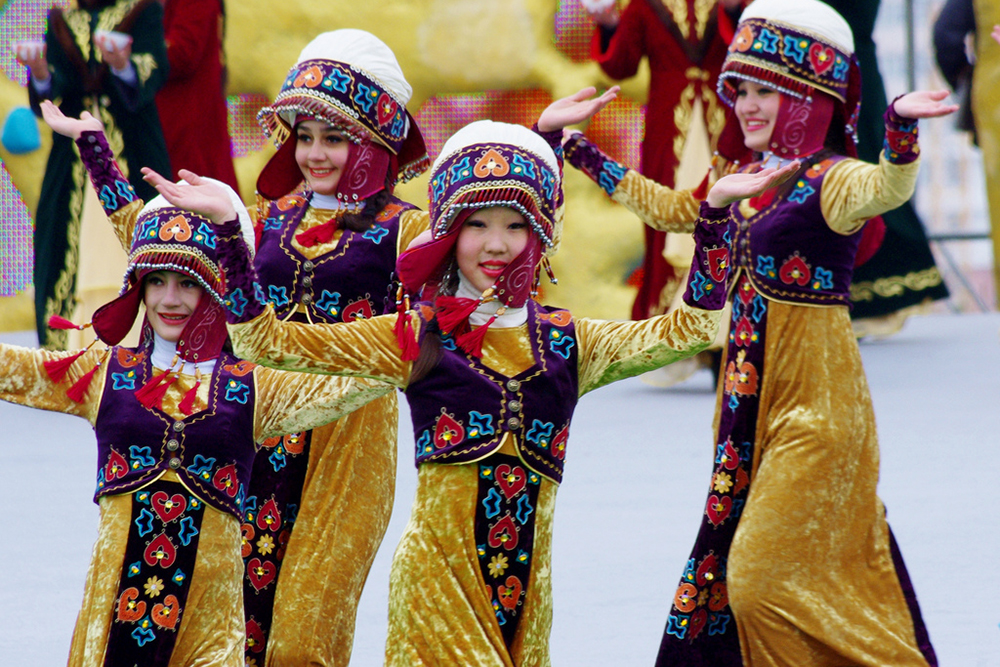 (Children dancing in Nowruz celebrations in Kazakhistan)
(Children dancing in Nowruz celebrations in Kazakhistan)
Parents and especially, grandparents, usually give their kids and grandkids a sum of money as “Eidi”. Because of this, as a kid growing up with this wonderful tradition, I was always waiting to collect my precious Eidi’s as soon as “Saal-Tahvil” happened and planning what I’m gonna buy with them sometimes weeks in advance!
This is an added bonus as it is unusual for a younger member of the family to give “Eidi” to their parent, grandparent or any other senior in the family. So basically the younger you are the more “Eidi’s” you get! 😀
In Nowruz, the most traditional food is “Sabzi Polo Mahi” or “Saffron Herb Rice with Fish”, but each family can cook a different dish depending on what they like. This year I decided to cook one of my favourite rice dishes called “Reshteh Polo” or “Saffron Rice with Noodles, Sultanas and Walnuts”.
You can have this tasty rice with grilled or stewed chicken or a meat stew, or even on its own because it has enough ingredients to fill you up easily 😀
The special ingredient in this dish is the “Reshteh” or Persian noodles for adding to rice. There are other Persian noodles, which are white and thicker. They are usually added to soups only. You can find “Reshteh” for rice in your local Persian grocery store.
Don’t be intimated by the look or the difficult name of this dish, it’s really super easy to make!
So without further a due, I present to you my “Reshteh Polo”!!
Ingredients:
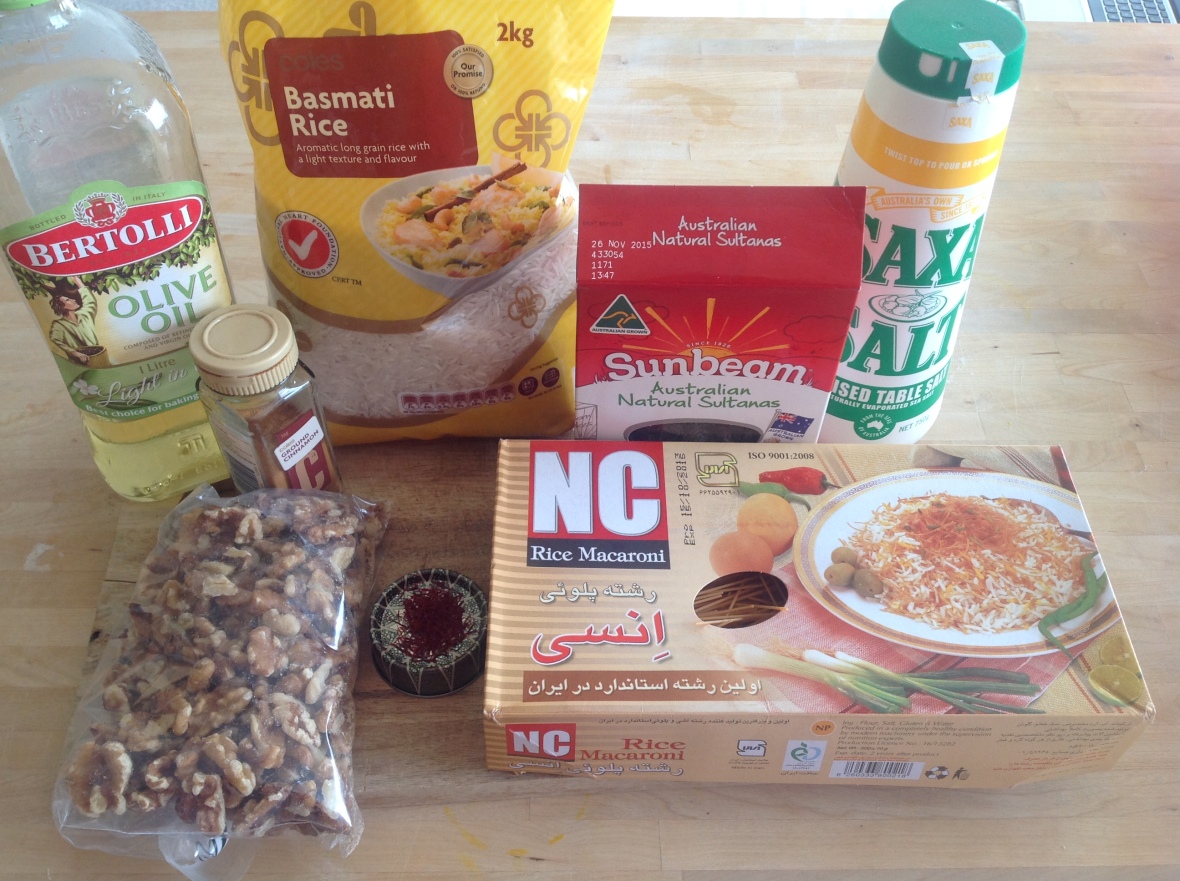
-1 fistful of Persian Noodles (reshteh) for rice, broken into 5 cm lengths
-2 cups Basmati rice
-A pinch of Saffron, brewed (recipe here)
-A handful of walnuts, chopped
-A handful of sultanas
-1/2 teaspoon of salt
-1 teaspoon of cinnamon
-Cooked pieces of chicken or meat
Method:
1- Rinse the rice with cold water a few times until the water passed is clear.
2- Place the rice in a pot, and pour cold water on it to cover it completely. Add the salt and stir.
3- Bring the pot to boil, let simmer for ~10 minutes, until rice is cooked. You want it to be cooked and a bit ardent. Then, drain and set aside.

4- Place the noodles in another pot of boiling water and let simmer for 3-5 minutes until al-dente.
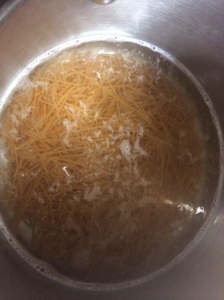
5- Drain the noodles, then mix through the rice.

6- Separate three table spoons of rice, add the saffron to it, and set aside.
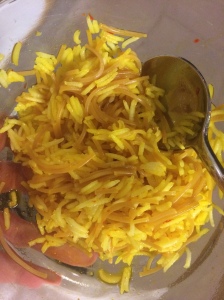
7- In a frying pan, add the walnuts, sultanas, chicken/meat pieces, cinnamon and a bit of olive oil.

8- Keep string this mixture on medium heat for a few minutes until you can smell the aroma of the walnuts and cinnamon.
9- Now you have all the necessary elements of “Reshteh Polo”, just assemble as you like!

Easiest way is to mix all of them together: saffron rice, noodle rice, and walnut-sultana mixture. Or, you can put the rice first in a dish and then decorate it with other elements as you wish.
Enjoy!~~~ (or Noosheh-Jaan in Farsi) 😀
Last but not least, I am a member of “Persian Food Bloggers”, a group of super-talented and creative Persian food bloggers who in celebration of Nowruz have all posted amazing recipes on their blog. Please have a look at their stunning dishes here:

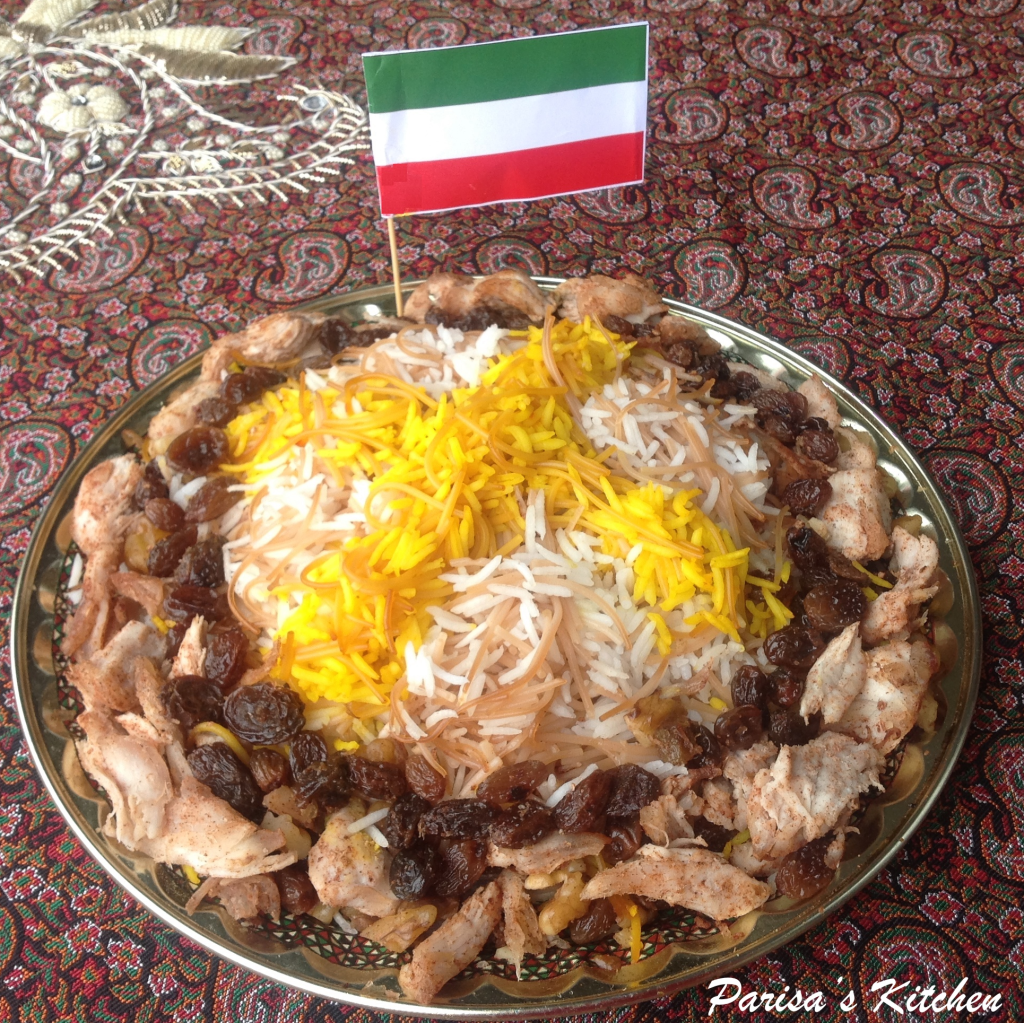


Darling Happy Nowruz. Your presentation for Nowruz is unique, full of beautiful colours announcing spring time in our dear country. Your passion and creativity have completed your colourful haft-seen design presenting your love of our deep and meaningful culture.
With Love,
Your mum
LikeLike
Thanks so much Maman jan! All I know is what you have taught me 😀 P.S. This reshteh polo is calling your name !!! 😆 xoxo
LikeLike
Absolutely delightful post with stories, colorful photos, music, dance and reshteh polo! I love reshteh polo and this one is special with the addition of walnuts. I really enjoyed the post. Happy Nowruz to you and yours!
LikeLike
Thanks a lot dear Fae! I’m glad you enjoyed it! I wish you and your loved ones a wonderful Nowruz too 🙂
LikeLiked by 1 person
I’ve never had this before, but it looks absolutely mouthwatering. I love the idea of incorporating reshteh into polow. Well done!
LikeLike
Thanks a lot Sina! Hope you like it when you give it a go!
LikeLike
Love this presentation about Nowruz and the rice. I will have to make it, hopefully tonight!
Eid-eh shomah mobarak!
LikeLiked by 1 person
Thank you Coco jan! Eide shoma ham mobarak! Wish you and your loved ones a year filled with happiness and health xx
LikeLike
Happy New Year Parisa joon! What a lovely post. I’ve never made reshteh polo but your recipe has inspired me to give it a try. Thanks so much for sharing!
LikeLike
Thank you lovely Naz!….Hope you’ve had a good “eid” too!… I’m glad you enjoyed the recipe 🙂
LikeLike